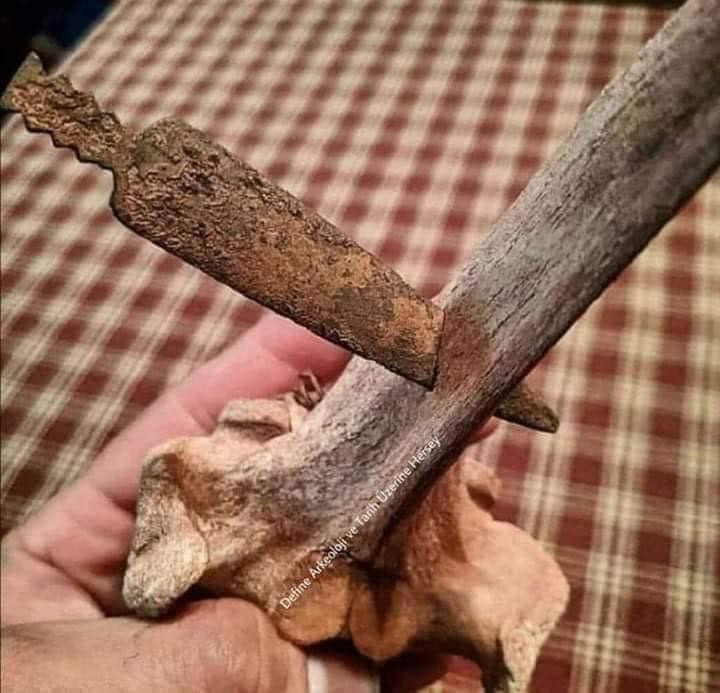The discovery of a 2,070-year-old bone with an iron spearhead still embedded in it offers a haunting glimpse into the harsh realities of the Roman Gallic wars. This extraordinary archaeological find not only highlights the ferocity of ancient conflicts but also serves as a tangible connection to the lives lost in these battles, urging us to reflect on the profound human cost of war and the enduring marks it leaves on history.
The spearhead, remarkably preserved with its tip still sharp after centuries, likely pierced the body of a warrior during the chaos of battle. The force and precision required to inflict such a wound speak volumes about the combat techniques and weaponry of the time. The bone itself, preserved as a silent witness to this tragedy, offers a poignant snapshot of a warrior’s final moments—a time capsule of pain, sacrifice, and the brutal realities of ancient warfare.

This rare artifact is being meticulously studied by researchers to uncover the secrets of the weapons and strategies employed by both Roman and Celtic warriors. The preservation of the spearhead within the bone provides a unique opportunity to examine the craftsmanship and technology of the era. By analyzing the metallurgy of the spearhead and the injuries it caused, archaeologists can piece together the violent encounters that shaped these historic conflicts. The find also sheds light on the physical toll these battles took on individuals, offering a stark reminder of the personal sacrifices made during such turbulent times.
The Roman Gallic wars, spanning from 43 to 84 AD, were a series of grueling confrontations between the expansive Roman Empire and the Celtic tribes of what are now modern-day Ireland and Scotland. These battles were characterized by relentless skirmishes, formidable sieges, and large-scale confrontations, as the Roman forces sought to extend their influence and the Celtic tribes fought to preserve their independence and way of life. The spearhead embedded in the bone stands as a chilling reminder of these struggles, encapsulating the ferocity and desperation of warriors on both sides.
Beyond its historical and archaeological importance, this discovery serves as a profound symbol of the enduring impact of war on humanity. It is a reminder that each artifact recovered from ancient battlefields carries with it the stories of individuals whose lives were forever altered—or ended—by conflict. These relics bridge the past and present, prompting us to consider the lessons history offers about the consequences of violence and the importance of striving for peace.
In analyzing this spearhead and its implications, researchers gain invaluable insights into the evolution of warfare. The Romans, known for their military innovations, employed sophisticated strategies and cutting-edge weaponry to dominate their adversaries. The Celts, with their fierce resistance and intricate knowledge of their homeland, presented formidable challenges to Roman expansion. This artifact not only reveals the brutal reality of their confrontations but also highlights the ingenuity and adaptability of both sides. It provides a tangible link to the strategies that defined these battles, from the precision of Roman formations to the guerrilla tactics of the Celts.
Equally significant is the role such discoveries play in fostering a deeper understanding of cultural identity and resilience. For the Celtic tribes, their resistance against Roman conquest was not merely a struggle for territory but a fight to preserve their traditions, autonomy, and heritage. The spearhead, lodged in the remains of one of their warriors, symbolizes the courage and tenacity that defined their resistance.
As we reflect on this discovery, it is impossible not to draw parallels between the ancient world and our own. The spearhead and bone remind us that the consequences of war—both physical and emotional—are universal and timeless. They underscore the fragility of human life and the profound cost of conflict, lessons that remain relevant in today’s world.
The story of this artifact also serves as a call to action for preserving history and learning from it. The meticulous work of archaeologists and historians ensures that the voices of the past are not lost but instead serve as a guide for future generations. Through their efforts, we gain not only knowledge of ancient societies but also a greater appreciation for the shared humanity that connects us across time.
This discovery is a vivid testament to the brutal nature of the Roman Gallic wars, yet it also embodies the resilience of the human spirit. It invites us to honor the memory of those who lived and died in these ancient conflicts while challenging us to build a future rooted in understanding and peace. By studying such artifacts, we gain not only a clearer picture of history but also a renewed commitment to avoiding the mistakes of the past.
In conclusion, the 2,070-year-old spearhead and bone offer more than just a glimpse into a violent chapter of history; they provide a profound opportunity for reflection. They remind us of the enduring impact of war on individuals and societies and underscore the importance of preserving the lessons of history. As we continue to unearth these remnants of the past, we carry forward the stories they tell, ensuring that their significance is not forgotten but instead serves as a beacon for progress and understanding in our modern world.





